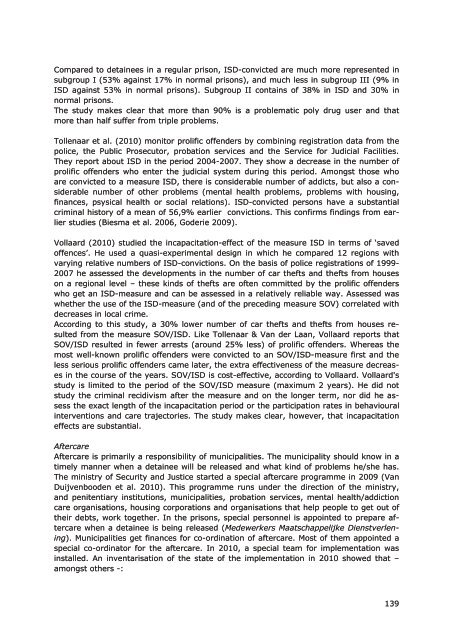The Netherlands Drug Situation 2010 - Trimbos-instituut
The Netherlands Drug Situation 2010 - Trimbos-instituut
The Netherlands Drug Situation 2010 - Trimbos-instituut
You also want an ePaper? Increase the reach of your titles
YUMPU automatically turns print PDFs into web optimized ePapers that Google loves.
Compared to detainees in a regular prison, ISD-convicted are much more represented insubgroup I (53% against 17% in normal prisons), and much less in subgroup III (9% inISD against 53% in normal prisons). Subgroup II contains of 38% in ISD and 30% innormal prisons.<strong>The</strong> study makes clear that more than 90% is a problematic poly drug user and thatmore than half suffer from triple problems.Tollenaar et al. (<strong>2010</strong>) monitor prolific offenders by combining registration data from thepolice, the Public Prosecutor, probation services and the Service for Judicial Facilities.<strong>The</strong>y report about ISD in the period 2004-2007. <strong>The</strong>y show a decrease in the number ofprolific offenders who enter the judicial system during this period. Amongst those whoare convicted to a measure ISD, there is considerable number of addicts, but also a considerablenumber of other problems (mental health problems, problems with housing,finances, psysical health or social relations). ISD-convicted persons have a substantialcriminal history of a mean of 56,9% earlier convictions. This confirms findings from earlierstudies (Biesma et al. 2006, Goderie 2009).Vollaard (<strong>2010</strong>) studied the incapacitation-effect of the measure ISD in terms of ‘savedoffences’. He used a quasi-experimental design in which he compared 12 regions withvarying relative numbers of ISD-convictions. On the basis of police registrations of 1999-2007 he assessed the developments in the number of car thefts and thefts from houseson a regional level – these kinds of thefts are often committed by the prolific offenderswho get an ISD-measure and can be assessed in a relatively reliable way. Assessed waswhether the use of the ISD-measure (and of the preceding measure SOV) correlated withdecreases in local crime.According to this study, a 30% lower number of car thefts and thefts from houses resultedfrom the measure SOV/ISD. Like Tollenaar & Van der Laan, Vollaard reports thatSOV/ISD resulted in fewer arrests (around 25% less) of prolific offenders. Whereas themost well-known prolific offenders were convicted to an SOV/ISD-measure first and theless serious prolific offenders came later, the extra effectiveness of the measure decreasesin the course of the years. SOV/ISD is cost-effective, according to Vollaard. Vollaard'sstudy is limited to the period of the SOV/ISD measure (maximum 2 years). He did notstudy the criminal recidivism after the measure and on the longer term, nor did he assessthe exact length of the incapacitation period or the participation rates in behaviouralinterventions and care trajectories. <strong>The</strong> study makes clear, however, that incapacitationeffects are substantial.AftercareAftercare is primarily a responsibility of municipalities. <strong>The</strong> municipality should know in atimely manner when a detainee will be released and what kind of problems he/she has.<strong>The</strong> ministry of Security and Justice started a special aftercare programme in 2009 (VanDuijvenbooden et al. <strong>2010</strong>). This programme runs under the direction of the ministry,and penitentiary institutions, municipalities, probation services, mental health/addictioncare organisations, housing corporations and organisations that help people to get out oftheir debts, work together. In the prisons, special personnel is appointed to prepare aftercarewhen a detainee is being released (Medewerkers Maatschappelijke Dienstverlening).Municipalities get finances for co-ordination of aftercare. Most of them appointed aspecial co-ordinator for the aftercare. In <strong>2010</strong>, a special team for implementation wasinstalled. An inventarisation of the state of the implementation in <strong>2010</strong> showed that –amongst others -:139




